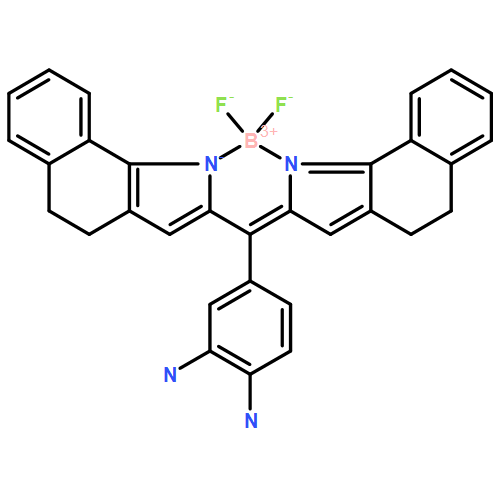Co-reporter: Hui-Xian Zhang, Jian-Bo Chen, Xiao-Feng Guo, Hong Wang, Hua-Shan Zhang
pp: 335-342
Publication Date(Web):15 November 2013
DOI: 10.1016/j.talanta.2013.05.043
•A novel NIR fluorescent probe DANPBO-H was combined with HPLC for NO detection.•DANPBO-H demonstrates excellent selectivity and high sensitivity for NO.•Interfering effects of complex samples are negligible with the use of DANPBO-H.•Analysis of NO in plant and mammal samples was used to verify the developed method.•The method provides a simple and reliable analysis strategy for detection of NO.Nitric oxide (NO) acts as an important regulator and mediator in numerous processes of biological systems. In this work, the analytical potential of a novel near-infrared (NIR, >600 nm) BODIPY-based fluorescent probe for NO, 8-(3,4-diaminophenyl)-4,4-difluoro-4-bora-3a,4a-diaza-di(1,2-dihydro) naphtho[b, g]s-indacene (DANPBO-H) has been evaluated in high performance liquid chromatography (HPLC). In 25 mM pH 6.50 borate buffer, DANPBO-H reacted with NO to give the corresponding triazole, DANPBO-H-T, at 35 °C for 20 min. DANPBO-H-T was eluted using a mobile phase of methanol/tetrahydrofuran/50 mM pH 7.00 H3Cit–NaOH buffer (81:7:12, v/v/v) in 4 min on a C8 column and detected with fluorescence detection at excitation and emission wavelengths of 621 and 631 nm, respectively. The limit of detection (LOD) (signal-to-noise=3) reached to 5.50×10−10 M. Excellent selectivity was observed against other reactive oxygen/nitrogen species. Various representative biological matrixes including the whole blood and organs of mice, the pangen and radical of rice, human vascular endothelial (ECV-304) cells and mouse macrophage (RAW 264.7) cells were used to verify the feasibility and resistance to interfering effects from complex biological sample matrixes of the developed DANPBO-H-based HPLC method. Compared to the existing derivatization-based HPLC methods for NO, the proposed method eliminates interfering effects from complex biological sample matrixes efficiently owing to the fluorescence detection in the NIR region, and is more advantageous and robust for the sensitive and selective determination of NO in complex biological samples.
Co-reporter: Hui-Xian Zhang, Jian-Bo Chen, Xiao-Feng Guo, Hong Wang, and Hua-Shan Zhang
pp: 3115
Publication Date(Web):February 24, 2014
DOI: 10.1021/ac4041718
Small-molecule fluorescent probes in combination with fluorescent microscopy can be a powerful tool to provide real-time detection and high spatiotemporal resolution of transient molecules in cells and bodies. For the design of fluorescent probes for transient molecule imaging, high detection sensitivity is crucial. In this report, two new fluorescent probes, 8-(3,4-diaminophenyl)-4,4-difluoro-4-bora-3a,4a-diaza-di(1,2-dihydro)naphtho[b,g]-s-indacene (DANPBO-H) and 8-(3,4-diaminophenyl)-1,7-dimethyl-4,4-difluoro-4-bora-3a,4a-diaza-di(1,2-dihydro)naphtho[b,g]-s-indacene (DANPBO-M), have been developed for nitric oxide (NO) imaging. The detection sensitivity has been efficiently improved by use of these probes through increasing NO detection signals and decreasing background fluorescence. Fluorescence in the far-red region is enhanced by 400- and 550-fold after reaction with NO is achieved and remains stable for at least 24 h under the irradiation of xenon lamp. Excitation and emission wavelengths longer than 600 nm and excellent intracellular retention of these probes and their NO products create dark background inside and outside cells and tissues. What is more, the excellent intracellular retention of these compounds is obtained by their strong lipophilicity, which is a novel design concept diametrically opposite to the traditional approaches. The high sensitivity and dark background make DANPBO-H and DANPBO-M competitive for NO imaging in cells and tissues. The lipophilicity-based intracellular retention mechanism as a design strategy has great potential in the development of fluorescent probes for bioimaging.
